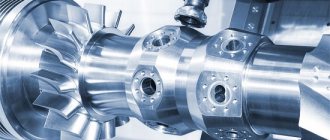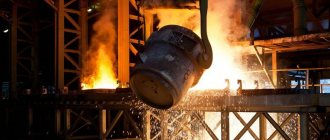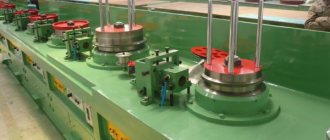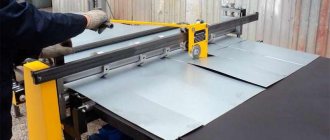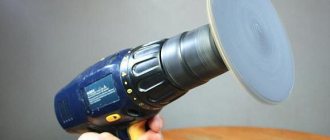23.03.2020
- Features of metalworking
- Electrical method of metal processing
- Welding
- Mechanical processing of metal parts
- Metal forming method
- Processing by cutting
- Chemical treatment
- Thermal metalworking
- Features of artistic processing
- Conclusion
Steel is one of the strongest materials, so it is used in almost all areas of mechanical engineering and production. In the article we will talk about the main types of mechanical processing of metal and metal products, the nuances of each method.
Features of metalworking
Every specialist working in this field must know not only the methods of cutting, grinding and rolling, but also how each material behaves under certain conditions. We list the key varieties:
- Electric. It is usually used in cases where it is necessary to make a small hole, as well as for a certain type of hardening.
- Mechanical. The most common group, it contains a large number of different methods.
- Chemical. Through a controlled reaction and chemicals (salts, alkalis), the properties of metals change, they become stronger or change their top layer.
Note! The listed types can be combined, for example, electrochemical processing.
- Pressure. Another common subtype, according to which an impressive force is exerted on the workpiece, for example, with a press. It is also often necessary to combine this method with heating.
- Thermal. This is not only hardening and other methods of increasing temperature, but also lowering it - cryogenic technology.
What does the type of metalworking depend on?
The main reason for choice is the technical characteristics of the metal, namely:
- its density;
- chemical activity;
- maximum and minimum permissible heating limits;
- fragility, etc.
The second decisive factor is the task. Based on it, you can choose methods that help cut the product, improve its physical and chemical properties, etc.
Table by type
| Process | Task |
| Rental | Giving the workpiece the required shape without compromising its integrity |
| Forging | Change in configuration along with deformation of the physical properties of the part under the influence of temperature |
| Press | Extrusion of the desired element with a double-sided pattern from a steel sheet or other plane |
| Drawing | Creating a Cross Section Profile |
| Volume stamping | Obtaining the product of the required shape |
| Grinding | Giving the surface the desired level of roughness and achieving precision |
| Cutting | Sawing a workpiece into two or more parts |
| Turning | Achieving a perfect cylinder and creating notches on it |
Pressure treatment
If mechanical types of metal processing are not suitable and it is necessary to maintain the integrity of the workpiece, craftsmen can use equipment that works with pressure. Technological processes in this case are divided into two groups:
- Stamping. This method uses two key elements - a punch and a die. The workpiece being processed is placed between these parts. Then, with the help of force, it moves. The workpiece takes the form of a matrix. There is hot and cold stamping. In the first option, the part is initially heated.
- Forging. In ancient times, blacksmiths forged weapons and armor. To do this, the workpiece was heated in a forge, and after that it was struck with a hammer. This changes the structure of the material and improves its characteristics.
Nowadays, forging uses pneumatic hammers and industrial furnaces.
Electrical method of metal processing
The destruction of the structure of a material under the influence of electricity has long been studied and actively used. The essence of the procedure is as follows: a spark with high voltage is applied to a certain small area. When a charge is formed and when it comes into contact with a metal surface, a very large amount of heat is released. Under the influence of temperature, the steel begins to melt and evaporate - a hole is formed in place.
The advantage of this method is the cleanliness of the cut and the virtually complete absence of residues and trimmings. And so that even those small particles that are formed do not fly apart, a small layer of oily liquid is poured into the contact zone. This film literally captures the elements.
Electrical processing
When processing metal electrically, a high-intensity discharge is applied. It destroys the surface of the workpiece. Technology used:
- if you need to make holes in a thin metal sheet;
- for sharpening tools;
- when processing workpieces made of hard alloys;
- to remove part of a broken drill or other element from a previously made hole (if this cannot be done in another way).
Voltage is applied to an electrode made of graphite or brass. The metal melts under this influence. In some cases, ultrasound is used. Oscillations with a frequency of 20 kHz or more obtained after applying voltage cause resonance. This leads to point destruction of the top layer of the workpiece. The method is applicable for working with stainless steel and durable alloys. Under the influence of ultrasound, not only metal, but also jewelry is destroyed.
Welding
This is the main method used to join two or more metal elements. A weld is produced by melting metal in a pool formed by an electric arc. When hardened, it becomes very durable, almost monolithic with the rest of the surface. There are different welding methods, the most common are:
- manual electric arc with electrodes;
- semi-automatic using filler wire.
The types of devices and the technology of conducting the arc, the mode is selected depending on the material and the required purpose. In some cases, preliminary procedures are carried out before welding - cleaning, trimming, cutting.
Mechanical processing of metal parts
When the tool interacts with the workpiece, the top layer can be removed - this is the most common result in this group of metalworking methods.
Drilling and turning
You can drill a through hole or a blind hole. It can be original or intended for subsequent carving. Drill as follows:
- First, the part is secured to the table, usually using a vice or a special clamp on the machine.
- Install the equipment. This can be a drill of different diameters and sharpening.
- The engine is started, followed by the natural movement of the tool simultaneously in two directions - around its axis and forward, cutting into the thickness of the metal.
The choice of drill should depend not only on the diameter of the required hole, but also on the density of the material. The tip may simply break if selected incorrectly.
Turning is the metal processing of cylindrical and conical workpieces on a lathe. The template is securely fixed in electrically driven spindles and rotates around its axis. The turner, using special tools that are clamped in a vice, directs the cutting edge to the required part. As a result, the top layer is cut off. Internal and external threads are also applied in a similar way.
Grinding and milling
The milling machine no longer works only with cylinders and cones, but also with other shapes. The operating principle is similar, but the workpiece no longer rotates, only the cutter moves. The standard sizes of cutters are very different; they are often represented by drills, reamers and other tools.
Grinding is designed to achieve maximum dimensional accuracy and the required roughness. When maximum smoothness is needed, abrasive wheels with a minimum abrasive size are used. You can also additionally polish the surface using a special polishing machine. Grinding is divided according to the degree of processing into rough or rough, fine and fine.
Equipment and tools used for metal machining
These are mainly machines and consumables. Large devices can be divided into manual control and CNC control panel. The former are cheaper and easier to learn, but they require constant presence and attention of the operator. And the latter allow you to make products with the maximum accuracy class.
There are also devices with modest dimensions that are convenient to carry in your hands, for example, for grinding. Some craftsmen make machine tools themselves; we will give an example in the following video of how to make a turning device in your garage:
A tool is a cutting edge, usually made of tool steel, and therefore has high strength.
Turning and drilling
The workpiece is fixed in spindles, which are connected to an electric drive and rotate rapidly. The cutter is fixed in the support and makes movements that are either directed by the operator’s hand or by the control system. You can grind cones, cylinders and other packaging parts.
Drilling is done to create holes. They do not have high precision, but are the basis for mechanical processing of metals, for example, for threading. Also similar procedures, but with greater accuracy, are reaming, reaming, boring and countersinking.
Metal forming method
In cases where the integrity of the specimen cannot be violated, but its shape needs to be changed, softer metalworking using presses and dies is used. The equipment works on the principle of exerting great pressure on the work area.
Rental
All rolled metal products are created using this technology, namely:
- sheets;
- pipes;
- shaped products.
The operating principle is as follows: the workpiece passes through compressed rollers, acquiring the required shape. Usually the cross-section is reduced, and the cut acquires the desired parameters. There are three subtypes of rolling:
- longitudinal, which is also the most common - during the operation, a sheet or pipe is fed lengthwise, its edges are compressed on all sides;
- transverse - there is no translational movement, this is how balls, bushings, and cylinders are processed;
- cross-helical - an average option, mainly used for parts with cavities inside.
Drawing
The purpose of this procedure is to reduce the size of the section of the part. During the operation, a larger workpiece is pulled through the dies. An example is the manufacture of wire (hence the name of the common material). First, a larger metal rope is passed through a series of dies. The method also has variations; drawing can be:
- dry – powder is used for lubrication;
- wet - soapy liquid is used;
- roughing and finishing;
- single and multiple;
- cold and hot.
Pressing
Using this metal processing technology, products are made from cast iron, aluminum and other brittle materials, which, under the influence of high temperature or without heating, acquire the desired shape. The workpiece is clamped in a matrix with holes. The press begins to operate from above. Under its influence, the substance is simply squeezed into pre-prepared containers. This is how spare parts are obtained for the automotive industry, aircraft manufacturing and other areas of production.
The matrix is usually prepared from heat-resistant steel, since heating is often necessary. Pressing happens:
- cold for aluminum, tin, copper;
- hot for cast iron, alloys containing nickel, titanium.
Forging
Each type of metal has its own temperature when it is amenable to the procedure. It is one of the most ancient, since even the forges of the Middle Ages worked on this principle - heating and mechanical action. Now everything has been brought to automaticity. There are three ways:
- machine with hammers (pneumatic and others);
- stamping – we classify this type of metalworking as a separate class;
- manual - almost never used.
Stamping
It can be voluminous and leafy. In the first case, three-dimensional products are obtained, in the second - stamps with flat parameters. The machine has two parts - a matrix and a punch. One of them is static, and the other is movable. Both of them are mirrored (in the case of working with sheets) or have different configurations, in accordance with the desired part. There is usually one or more gaps between two elements where excess is squeezed out. Then it is cleaned off, and the workpiece itself is polished in this place. But there are also completely closed dies that do not have such holes on the sides; then it is necessary to accurately distribute the amounts of metal.
There are two types of sheet stamping:
- formative - the element receives the bends necessary for the part;
- edged - figured cutting occurs.
A simple example of a technological procedure is the minting of coins.
Relevance of metalworking
Metal processing is rightfully considered one of the most ancient industries, the history of which goes back tens of thousands of years: from the manual processing of non-ferrous metals by ancient people to complex high-tech production processes using modern equipment.
Currently, metalworking is the fundamental basis of a huge number of technological processes, including a wide range of different methods and equipment used, the totality of which allows for the production of high-quality, reliable and durable metal products.
Processing by cutting
You can cut both a metal sheet and any hollow or solid element, for example, a rope. You can cut directly or use a curly procedure. In the first case, even manual shears for sheet steel are possible, and in the second, you cannot do without high-tech machines with a finishing control panel.
CNC equipment of high quality and at affordable prices can be purchased on the website. Here you will find a wide range of products for the professional production of metal products.
Cutting methods:
- A circular saw is a home option with low accuracy and high labor costs.
- Grinder – also used mainly for home use.
- Guillotine - is a machine where the blade is lowered onto the working area at high speed and under pressure.
- A band saw is the best option because it has many technological capabilities and produces smooth edges.
- Oxygen metalworking – suitable for alloys with low alloying components. An oxide film may remain on the material and must be removed.
- Laser - the laser promotes the formation of high temperatures, which are directed to a specific sawing site. A very progressive method.
- Plasma is the best and most accurate method, in which the excess substance at the melting site simply evaporates, leaving very clean edges.
Cutting is also carried out using turning, milling and other equipment - the top layer is removed using the cutting edge of the tools.
Comparative table of cutting conditions on different machines
| Type of transaction | What parameters need to be controlled? |
| Turning |
|
| Milling |
|
| Drilling |
|
| Gear cutter |
|
| Grinding |
|
Metal forming
This is a procedure in which integrity is not compromised - the top layer remains in place. But the form changes significantly. This is done by stamping, pressing or forging. Often the process is accompanied by heating the element to a temperature exceeding the temperature of plastic deformation. For example, forged parts are heated and then struck several times. And for stamping, two metal figures are used simultaneously, which mirror each other - a matrix and a punch. A steel sheet is clamped between them.
Chemical treatment
Chemicals facilitate reactions that allow:
- clean the surface from corrosion and contamination;
- apply an additional protective layer - galvanizing, galvanizing;
- increase resistance to external influences.
Typically, ozonation, chrome plating, galvanizing, boriding and application of a composition with aluminum are used.
Thermal metalworking
The use of high temperatures is intended to improve the characteristics of the steel. Each alloy has its own limiting boundaries at which the crystal lattice collapses or changes; after cooling it usually becomes stronger.
Annealing
Serves to increase ductility and malleability, that is, it is mainly used before other processing methods. Typically used after casting to remove internal stress in the workpiece. To carry out the operation, the steel is heated and left to cool slowly directly in the furnace.
Hardening
The goal is to increase hardness, but this may also increase fragility. The difference in the process is that after heating, a high temperature is maintained for some time, while cooling, on the contrary, is very rapid - in oil or water.
Vacation
This is the second stage after hardening to reduce brittleness. In fact, this is secondary heating with slow cooling, but at less high temperature influences.
Aging
This is a decorative method to obtain a beautiful aged surface, but without spoiling the basic qualities.
Normalization
This is a change in grain size - from coarse to fine. This is done to increase malleability.
Features of artistic processing
Metal structures are created for the decoration of buildings, for the production of functional, but at the same time beautiful household items. You can use casting, embossing, welding, and figured cutting to achieve highly aesthetic products. Chemical procedures are also sometimes used to apply a pattern - etching.
